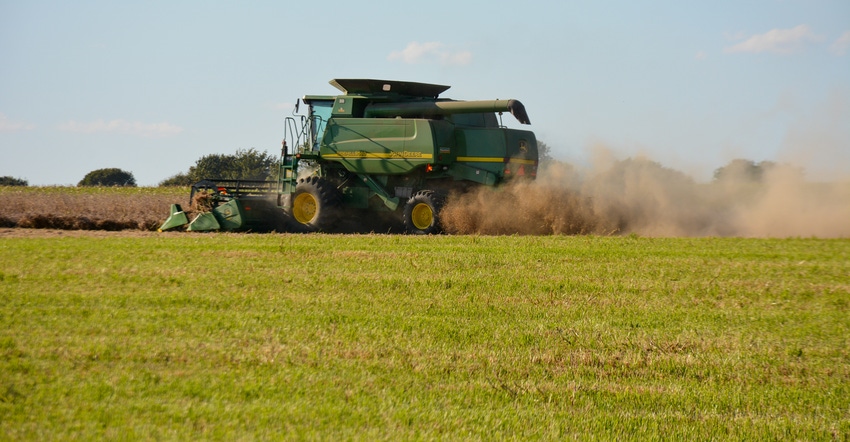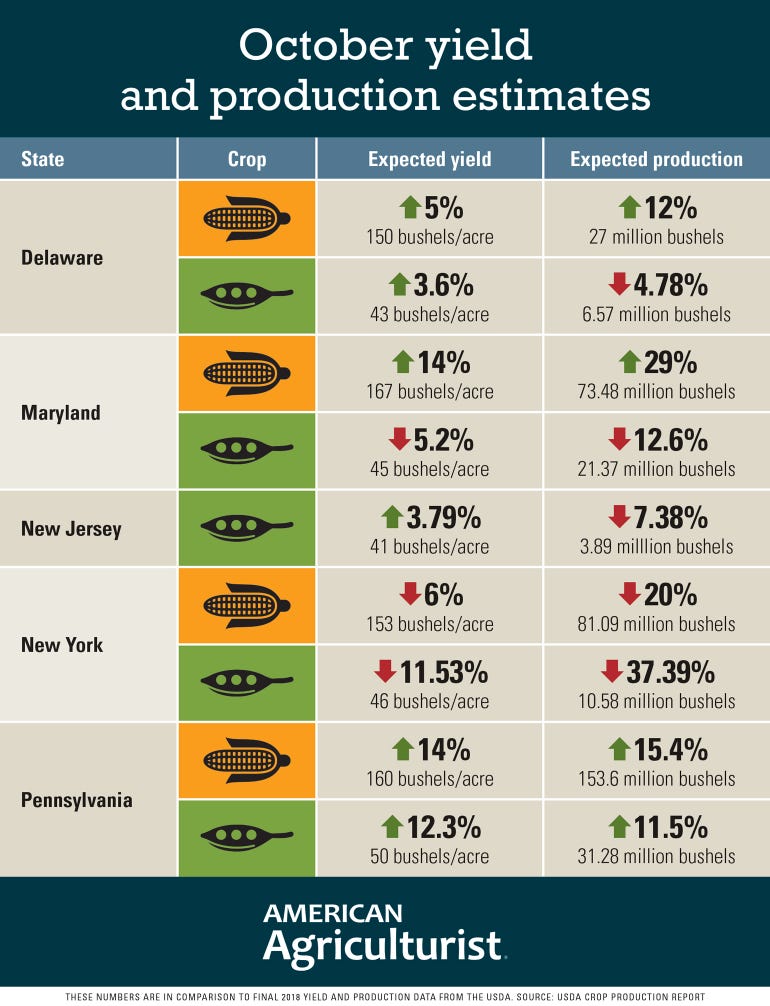
Corn yield and production are up in Pennsylvania for the second straight month, according to the October updated crop production report from USDA.
Once again, most farmers surveyed are reporting higher corn and soybean yields in 2019, but overall production is mixed.
Corn production and yield as well as soybean production and yield were adjusted up for Pennsylvania. Many farmers, especially in Lancaster County, have reported record yields as a result of ideal weather.
Delaware’s corn and soybean production and yields fell, likely the result of dry weather in August and September. Maryland corn production and yields, as well as the soybean yield were up, but overall soybean production declined.
The corn yield in New York is down but overall production increased slightly. Soybean production and yields are down as farmers had a tough time getting a crop in due to the cold and wet spring.
Soybean yields and production are also down in New Jersey.
The graphic below illustrates corn and soybean production, and yields, in the four major corn and soybean states of the region in comparison to 2018. We will update it when future reports are released.

Tobacco production and yield in Pennsylvania were left unchanged in the October report. Farmers are forecast to produce 13.26 million pounds of tobacco, down significantly from 2018 when farmers produced 17.4 million pounds.
The yield is forecast at 2,326 pounds per acre, up slightly from 2,300 pounds last year.
U.S. corn production is forecast at 13.8 billion bushels, down less than 1% from September and down 4% from last year. Yields are expected to average 168.4 bushels per acre, up 0.2 bushels from the previous forecast but down 8.0 bushels from 2018.
Farmers are expected to harvest 81.8 million acres of grain, down less than 1% from September but up slightly from last year.
Soybean production declined 2% from the September forecast at 3.55 billion bushels, down 20% from 2018. Yields are forecast at 46.9 bushels, down 1.0 bushel from September and down 3.7 bushels from last year.
Farmers are expected to harvest 75.6 million acres, down less than 1% from September and down 14% from 2018.
Grain in New York
Combines have slowly started to appear on fields in the Empire State.
Corn is still way behind with 44% of the crop mature; the average is 67% mature for this time of year, according to Tuesday’s Crop Progress Report.
Only 6% of grain has been harvested, behind the five-year average of 12%.
Many areas of the state, especially in the North Country, have likely already experienced first frost or have come close. If there is still a milk line in the corn, indicating that moisture is still above 35%, that could affect yield and test weights. If corn has reached black layer, grain yield and quality are usually not affected by frost.
Jeff Graybill, Penn State agronomy Extension educator, says drydown will be slower when frost happens. Corn tends to dry down half a percentage point each day in fall depending on weather conditions.
He says frosted corn can be left to stand for grain, but the less mature it is the more susceptible it will become to molds so it should be monitored closely.
When it comes to silage, the target for dry matter content is between 32% and 38%, according to Larry Chase, professor of animal science at Cornell.
Using whole-plant dry matter content is a better way to evaluate silage harvest timing, he says, as milk line is not a good indicator for many hybrids.
Chase says farmers should consider using a bacterial silage inoculant to help with fermentation efficiency and dry matter recovery. Immature silage should be stored separately, if possible, as this provides better flexibility at feeding as well as better allocation to specific animal groups, he says.
Find more information on management of frosted corn at bit.ly/cornsilagemanagement.
Drought hammers soybeans
Pockets of severe drought are popping up in southern West Virginia, while most of Maryland and Delaware are in a moderate drought.
This is really helping corn dry down, but soybean quality is bad, especially in places with no irrigation.
In Maryland, 81% of corn grain has been harvested, well-ahead of the five-year average of 52%. Soybeans are 25% harvested while 69% of the crop is mature, well-ahead of the 48% average. But the quality of the crop is not good with 40% reported in either poor or very poor condition.
Corn is 78% harvested in Delaware, ahead of the five-year average of 72%. Soybeans are also ahead of schedule with 57% of the crop mature, ahead of the 42% average, with 8% of the crop harvested.
Like Maryland, though, the quality of the crop is suffering. Surveyed farmers reported 46% of the crop in poor condition with 9% of the crop in very poor condition.
About the Author(s)
You May Also Like






